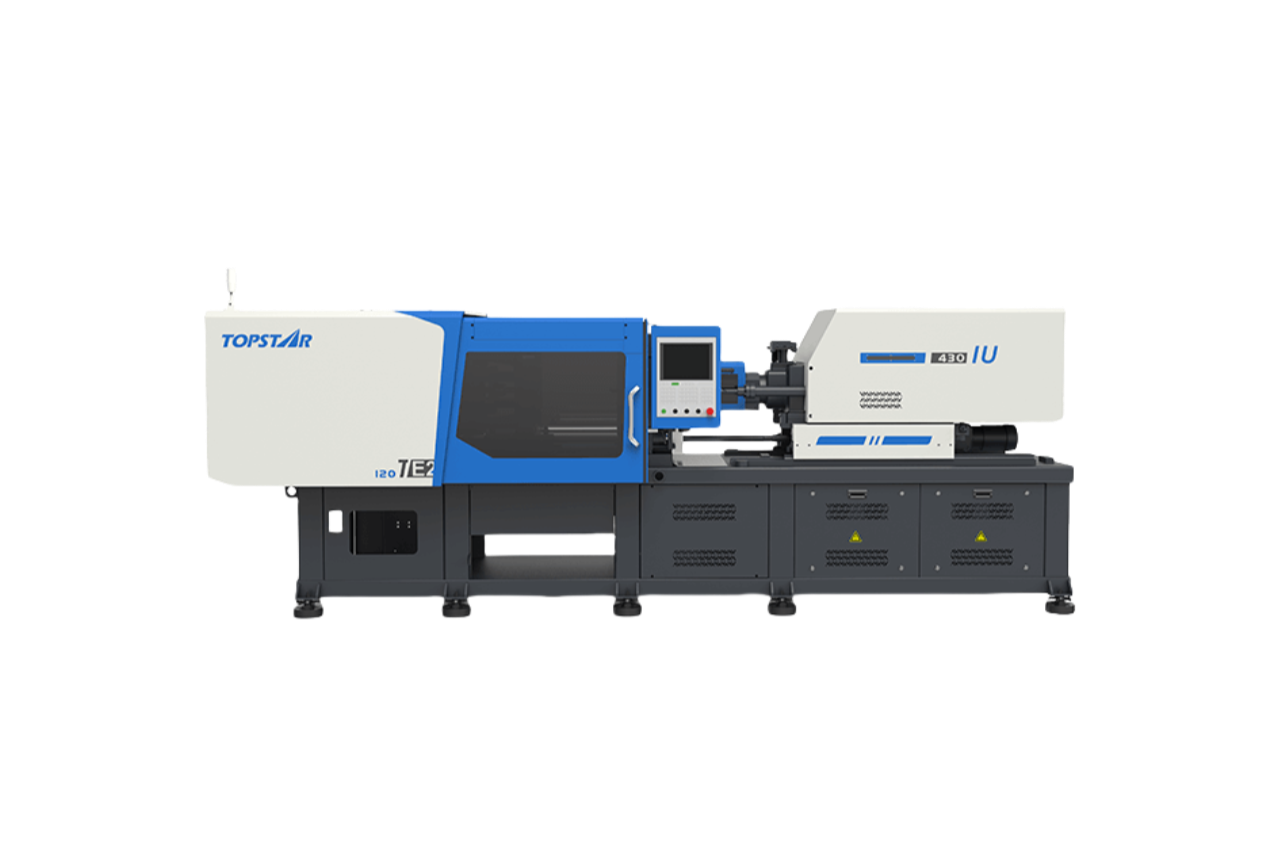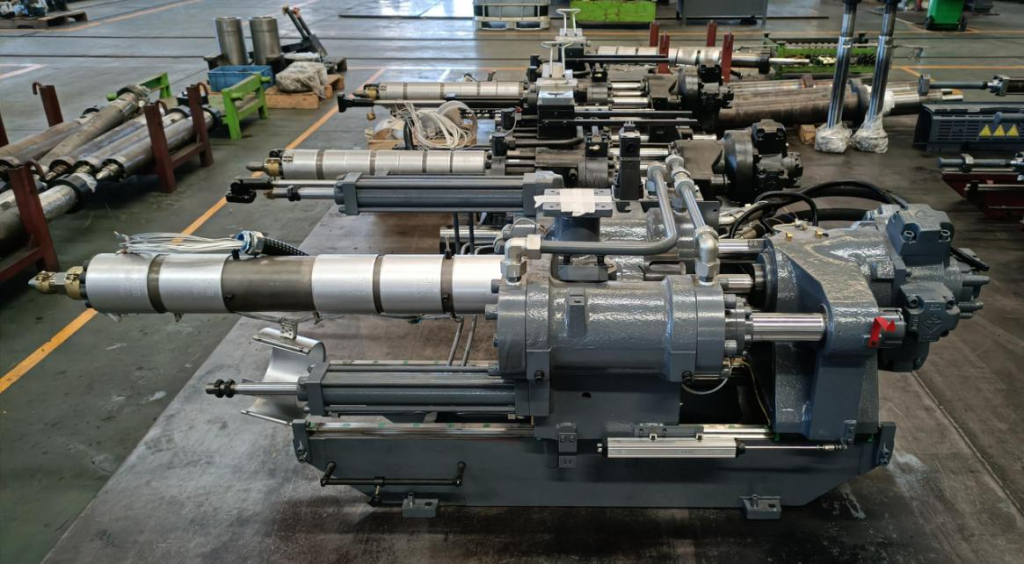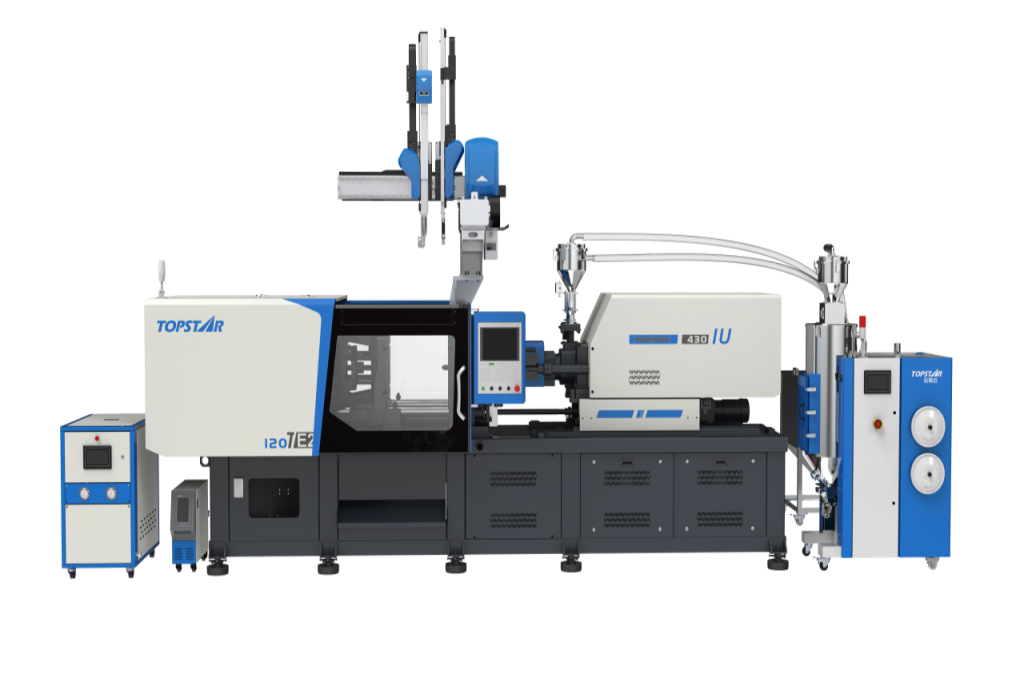How to increase the injection rate of plastic molding machines?
2025/06/23 By Topstar

When pursuing the goal of increasing the output of plastic molding machines during injection molding, one key factor that needs improvement is the injection rate. The injection rate is the speed at which the molten resin is pressed into the mold, and it is also one of the key factors that determine the cycle time and total output of any injection molding machine. Faster injection rates result in shorter cycle times, enabling the production of more parts per hour. Therefore, we need to improve the injection rate of plastic molding machines by adjusting various factors, including the geometry of the screw and barrel, the nozzle design, and the process parameters.
Optimizing the screw, barrel and nozzle design of plastic molding machines
The mechanical design of plastic molding machines forms the basis for accelerating injection molding. The compression ratio of the screw of Topstar’s high-speed plastic molding machine is between 1:1.2 and 1:1.4, which can accelerate the melting of the feed zone, thereby supplying more homogeneous resin to the nozzle. At the same time, we will increase the inner diameter of the barrel by 5-10 mm and match it with a deeper metering thread to reduce the melt pressure during high-speed injection molding. For example, in production trials for automotive interiors, upgrading the standard 45 mm screw to a 50 mm screw increased melt throughput by more than 20%.
Nozzle design is equally important. Our TE series electric injection molding machines are equipped with interchangeable nozzles featuring optimized nozzle tip geometry, such as streamlined, tapered flow nozzles, which minimize flow resistance and ensure polished inner surfaces to prevent early freezing during rapid filling, thereby maintaining high injection capacity.

Using electric servo systems
Traditional hydraulic systems may be robust, but they sometimes lack the precise, instantaneous response required for peak injection rates. Therefore, in modern injection molding production, to improve injection efficiency, electric plastic molding machines are selected, utilizing highly responsive all-electric drive systems to provide high-speed plunger acceleration and deceleration. This directly translates into breakneck injection speeds while maintaining precise control of the pressure curve. The instantaneous response of these systems eliminates lag, ensuring that the molten plastic enters the mold cavity at the maximum speed that the material and part geometry can achieve, thereby significantly improving the overall injection rate.
Secondly, our TE Series all-electric plastic molding machines feature direct-drive ball screws and high-torque servo motors for faster acceleration and deceleration. These machines can achieve injection speeds up to 400 mm/s, nearly twice that of a standard hydraulic press, while also providing repeatable accuracy.

Adjusting the process parameters of the plastic molding machines
Adjusting the process parameters during production Increases the injection rate of the plastic molding machine. First, increase the melt temperature to reduce viscosity within the range recommended by the resin supplier. Next, increase the injection speed in controlled increments and monitor the cavity pressure profile to detect signs of jetting or burning. Then, adjust the back pressure down to 5-8 bar to minimize screw slippage while preventing unmelted resin.
Operators typically employ a multi-stage speed profile, then gradually decelerate near the gate freeze point. This approach, implemented through the control touchscreen of the injection molding machine, can reduce fill time by up to 30% while maintaining dimensional accuracy, ensuring that your plastic injection molding machine operates at peak speed without compromising quality.

Achieve Precise Melt Temperature Control
Precise temperature management also enables higher injection speeds on plastic molding machines. Specifically, if the melt temperature is too low, viscosity increases dramatically, forcing the injection molding machine to push the material into the mold at a higher speed and slower rate. Conversely, overheating can cause polymer degradation. Topstar uses a highly responsive, multi-zone barrel heating and temperature control system. This ensures that the polymer always reaches its ideal processing temperature. This process keeps the melt at a lower, more stable viscosity and significantly cuts flow resistance during high-speed injection. Additionally, we recommend using valve-controlled hot runner nozzles in critical applications to prevent frozen material blocks that can hinder injection recovery. In our field tests, using a high-flow manifold reduced the filling time of a 32-cavity cover mold by 0.2 seconds, equivalent to producing 200 more parts per hour.
Leverage real-time monitoring and control technology.
To maintain a high injection rate, you need adaptive, data-driven control. Topstar’s equipment features a real-time process monitoring system that tracks injection speed, cavity pressure, and screw position in milliseconds. Therefore, by implementing pressure control at the mold gate, the system automatically adjusts the speed to maintain the target pressure profile, ensuring consistent cavity filling over thousands of cycles. At the same time, automatic deceleration is employed at the end of filling to prevent burrs, as well as customizable curve storage, which allows operators to select the optimal injection curve for each mold and maintain optimal injection performance.
Achieving high injection rates
Increasing the injection rate of plastic molding machines requires optimizing screw, barrel and nozzle design, adjusting process parameters, adopting electric drive systems, and deploying real-time monitoring technology to increase injection rates, thereby reducing cycle time, increasing output by 20%, and maintaining stable part quality. From precision mechanical design to high-torque electric servo drives and adaptive data-driven monitoring, each element works together to maintain optimal performance without compromising part quality.
TRENDING POSTS
- TOPSTAR Global Open Day 2025: Humanoid Robot Debuts, Pioneering a New Decade of Intelligent Manufacturing 2025/06/23
- Topstar Showcases TE II Electric Injection Molding Machines at InterPlas Thailand 2025 2025/06/23
- Topstar Expands Its Ecosystem Partnerships to Drive Smart Manufacturing Innovation 2025/06/23
- What factors can cause delays in the injection molding process of plastic molding machine? 2025/06/23
HOT TOPIC
- .ervo motor-driven linear robots
- •
- 1.0 guangdong topstar technology co. ltd
- 1.0 topstar china
- 1.0 topstar robot
- 11
- 160℃ mold temperature controller
- 170 ton injection molding machine
- 2
- 21
- 23
- 3 axis robot
- 3 axis robots
- 3 in 1 Compact Dehumidifying Dryer
- 3-axis robot
- 3-axis robots
- 39
- 41
- 460T injection molding machine
- 5-axis CNC machine
- 62
- 90 ton injection molding machine
- accuracy
- Air Chillers
- all electric injection molding machine
- all electric injection molding machines
- All-electric injection molding machines
- and overall production quality. Therefore
- AP-RubberPlas
- automated injection molding machine
- Automation changed engineering
- automation of injection molding robots
- automotive parts injection molding
- auxiliary machine
- Bench Injection Molding Machine
- Cabinet dryer manufacturers
- Cabinet dryers
- chiller
- CNC Drilling Machine
- CNC Drilling Machines
- cnc engraving machine manufacturer
- cnc laser cutting machine manufacturer
- CNC machine
- CNC Machine Center
- CNC Machine for Sale
- CNC Machine Manufacturing
- CNC Machine Tool
- CNC machine tool product
- CNC Machining Center
- CNC wood carving machine
- Cooling system
- Cross-Walking Single Axis Servo Cylinder Robot
- Cross-Walking Single-Axis Servo Cylinder Robot
- Cross-Walking Three-Axis/Five-Axis Servo Driven Robot
- cross-walking three-axis/five-axis servo-driven robot
- Dehumidifier Dryer
- Dehumidifying Dryer
- delta parallel robot
- Desktop Injection Molding Machine
- Desktop injection molding machines
- Desktop Molding Machine
- desktop plastic injection machine
- Desktop Plastic Injection Molding Machine
- Digital Transformation
- direct clamp injection molding machine
- Direct clamp injection molding machines
- Dosing & mixing system
- Drilling Centers
- Drying and dehumidification system
- drying and dehumidifying equipment
- Drying and Dehumidifying System
- drying system
- effective and efficient. Cabinet dryers are also used in other industries where large quantities of material need to be dried
- efficient injection molding machine
- elbow hydraulic injection molding machines
- electric injection molding machine
- electric injection molding machines
- energy-efficient injection molding robot
- energy-efficient water chiller
- energy-efficient water chillers
- energy-saving injection molding machine
- etc. Among injection molding robots
- exhibition
- features of CNC machine
- Feeding And Conveying System
- Five Axis Machine Center
- Flexible Production Line
- Fully automatic injection molding machine
- Gathering Topstar
- giant injection molding machine
- GMU-600 5-Axis Machining Center
- Granulating & Recycling System
- Heavy duty injection molding machine
- High-precision electric molding machines
- high-precision plastic molding machines
- high-speed all electric injection molding machine
- high-speed electric injection molding machine
- High-Speed Packaging Injection Molding
- Honeycomb rotor dehumidifier
- horizontal injection molding machine
- Horizontal Injection Molding Machines
- Horizontal Injection Moulding Machine
- Horizontal Mixer manufacturer
- How The CNC Machine Works
- hybrid injection molding machine
- hydraulic injection molding machine
- Hydraulic Injection Molding Machines
- in this article
- Industrial AI
- Industrial Automation
- Industrial robot
- Industrial Robot Chinese brand
- industrial robot parts
- industrial robot supplier
- Industrial robots
- Industry Chain
- Injection Manipulator
- injection manipulator robot
- injection mold machines
- Injection molding
- Injection molding automation
- Injection Molding Automation Solution
- injection molding dryer
- Injection molding equipment
- injection molding hopper dryer
- Injection molding machine
- injection molding machine brand
- Injection Molding Machine Factory
- Injection Molding Machine Manufacture
- Injection molding machine manufacturer
- injection molding machine manufacturers
- Injection molding machine procurement
- injection molding machine robotic arm
- injection molding machine with a robot
- Injection molding machines
- injection molding material dehumidifying
- injection molding plant
- injection molding process
- Injection Molding Robot
- injection molding robot arm
- Injection molding robot automation
- Injection molding robotic arm
- injection molding robots
- Injection moulding machine
- injection moulding machines
- Injection Moulding Robots
- Injection Robot
- Injection robot arm
- Injection robot manufacturer
- Injection robot wholesale
- injection robots
- Intelligent Factory
- intelligent injection molding machines
- Intelligent Manufacturing
- intelligent mold temperature
- intelligent mold temperature controller
- Intelligent mould temperature controller
- InterPlas Thailand 2025
- Introducing Injection Robot
- It is the best choice for drying large quantities of material at once. Cabinetmakers use these machines because they are fast
- Large flow water type mold temperature controller
- large injection molding machine
- large injection molding machines
- Learn what industrial automation and robotics is
- linear robot
- linear robots
- low speed sound-proof granulator
- machine plastic molding
- make sure to add some! Improvements (2) Keyphrase in introduction: Your keyphrase or its synonyms appear in the first paragraph of the copy
- manipulator machine
- manufacturing
- Manufacturing Innovation
- medical grade injection molding machines
- Medical Injection Molding
- medical injection molding machine
- medical injection molding machines
- micro injection molding machine
- middle speed granulator
- Mini CNC machine manufacturers.
- mobile cover making machine
- Mold Temperature Control System
- mold temperature controller
- mold temperature controllers
- molding machine
- molding material Dehumidifying System
- mould temperature control system
- mould temperature controller
- mould temperature controllers
- New electric injection molding machine
- nitrogen dryer manufacturer
- nitrogen dryer system manufacturer
- Oil type mold temperature controller
- Oil type mold temperature controllers
- open day
- optical component injection molding
- Outbound links: No outbound links appear in this page. Add some! Images: No images appear on this page. Add some! Internal links: No internal links appear in this page
- packaging injection molding
- Packaging Solutions
- PET Preform injection molding
- phone case maker machine
- phone case making machine
- phone cover making machine
- plastic bottle making machine
- plastic bottle manufacturing
- plastic bucket making machine
- plastic bucket manufacturing
- Plastic chair making machine
- plastic forming equipment
- plastic hopper dryer
- plastic injection machine
- plastic injection machines
- plastic injection molding
- Plastic injection molding equipment
- Plastic injection molding machine
- Plastic Injection Molding Machines
- plastic injection moulding machine
- plastic injection moulding machines
- plastic injection robot
- plastic molding
- Plastic Molding Industry
- Plastic Molding machine
- plastic molding machine 1
- Plastic Molding Machines
- plastic molding press
- plastic moulding machine
- plastic phone case making machine
- plastic-molding machine
- powerful granulator
- Powerful Type Sound-Proof Granulator
- precision injection molding
- precision injection molding machines
- production of plastic seats
- pure water mould temperature controller
- Robot injection molding
- robot injection molding machine
- robot manufacturing companies
- Robotic arm for injection molding machine
- robotic injection molding machines
- robotics in injection molding
- SCARA robot
- SCARA robots
- Service-oriented manufacturing
- Servo Cylinder Robot
- servo driven robot
- Servo Driven Robots
- servo injection molding machine
- servo injection robots
- servo motor-driven linear robots
- servo-driven 3-axis robot
- Servo-Driven Robot
- Setup of injection machine
- Silicone Injection Molding Machine
- six-axis industrial robot
- Smart Manufacturing
- Stainless Hopper Dryer
- Stainless Hopper Dryers
- star club
- swing arm robot
- take-out robot
- take-out robots
- Thailand 4.0
- the choice between servo-driven robots and hydraulic robots will have a certain impact on efficiency
- the most popular injection molding machine
- the type of injection molding robot
- TIC2000 Control System
- TMII injection molding machine
- toggle clamp injection molding machine
- Toggle Hydraulic Injection Molding Machines
- toggle injection molding machine
- Top 10 brands of injection robots
- Topstar
- Topstar Electric Injection Molding Machine InterPlas Thailand 2025 Smart Manufacturing Thailand 4.0
- Topstar Engineering
- Topstar Industrial Robots
- Topstar injection molding intelligent
- Topstar Scara Robots
- Useful Injection molding machine
- Vertical machining centers
- volumetric type blender
- water chiller
- water chillers
- water distributor
- water type mold temperature controller
- Water Type MoldTemperature Controller
- Water-Type Mould Temperature Controllers
- We often face choices when performing injection molding. We will choose the type of injection molding machine
- wholesale of injection molding machines
- x carve CNC
- 热门查询 点击次数 展示 排名 topstar
